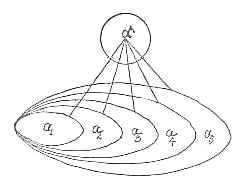
Boris Sidis Archives Menu Table of Contents Appendix 1
|
THE FOUNDATIONS OF NORMAL AND ABNORMAL PSYCHOLOGY Boris Sidis, Ph.D., M.D. © 1914 |
PART II
CHAPTER XXIII
THE SYNTHETIC MOMENT OF SELF-CONSCIOUSNESS
In the higher stages of the recognitive moment the states in the series are no longer isolated. Each succeeding state embraces or truer to say includes and represents the preceding one. The whole series is essentially an interconnected one. The states in the series not only refer to the original experience of the object as presented, but also to each other in the order of their succession. Let A be the original experience of which A is presentative and a is representative, then the state of the recognitive moment may be represented by aA. State a refers to aA, but also to a. The same holds true in the case of the other states,―a2 refers to aA and a1 and not only to a1 alone but also to a; a3 refers once more to aA and also to a2, a1, a, and so on; each succeeding state refers to the original experience and also to the preceding states of recognition. In other words, each state represents not only the original sensory experience, but also some though not all of the preceding series of representations. There is, in short, awareness in the act of recognition. The preceding state modifies the succeeding one, and this latter is fully aware of the former. This awareness is present during the very occurrence of each state in the series.
The reproduced state in its recognition recognizes the object as presented to sense-experience, recognizes, or is aware at least, that it has had some such recognitions on previous occasions, and at the same time recognizes, or is aware of its present recognition. Such a recognitive moment, the highest of all the moments-consciousness, is characteristic of the fully developed adult human consciousness or of self-consciousness and may be termed the synthetic moment of self-consciousness. The synthetic moment of self-consciousness forms a series of selves―the present or the percipient self, the past or the perceived self and the intermediate selves connecting the two selves as termini, the whole forming a series synthetized by the life of the synthetic moment of self-consciousness.
If we retain our
previous denotation of objects and of the series of recognitive states and
denote the recognitive reproduction by attaching the denotation of the presented
object as index to the state then the state may be denoted by aA, the succeeding
states in the simple recognitive moment may be denoted by aA, a2A,
a3A, a4A,
a5A, a6A.
The states in the series of the synthetic moment of self-consciousness may then
be represented by the following formula:

and so on the last being extremely complicated . . .
Graphically the synthetic moment of self-consciousness may be represented as follows:

All along our analysis of reproduction we have at the same time by implication discussed the various types and forms of what may be conveniently termed as germinal memory in the states of consciousness of the lower animals. Memory, however, is not present in the lower animals types of moment-consciousness. Memory really begins with the recognitive moment and reaches its full perfection in the adult human consciousness,―in the synthetic moment of self-consciousness. It is only in the moment of self-consciousness that all the characteristics of memory are to be formed, namely, reproduction; not reinstatement, but reproduction after the kind of recognitive moment, recognition, definite localization in the past and finally awareness of its own activity, or rather self-awareness. Memory germinates and grows in the recognitive moment, and blossoms in the personality moment.